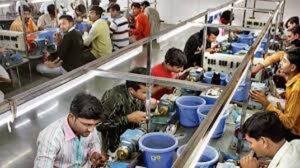Rajkot and Surat districts will come out of the lockdown blues soon, says a study by Levers For Change (LFC), a decade-old Business Transformation Consultancy firm based in Indore, Madhya Pradesh,

According to the study, “Gujarat is the third-largest economy of India, contributing as much as 9% to national GDP. It has four larger economic districts – Ahmedabad, Rajkot, Surat, and Vadodara. The scenario is different from the rest of the nation as manufacturing, instead of services, is its biggest contributor to the state’s economy.”
Being self-reliant in the defence sector is the need of the hour. Here is a perspective on how India is doing it. https://t.co/pD7LOOGspD
— Narendra Modi (@narendramodi) May 30, 2020
Given the current rate of spread of COVID, it is clear that the state needs more time to come out of lockdown impact. However, Surat and Rajkot, where the spread has been controlled, can come out of lockdown a tad earlier. The export-oriented manufacturing units at Surat will take more time to stabilise as international trade has been hampered by COVID but the low-cost agri-input industry at Rajkot may see an early revival.
India is extremely proud of our farmers. They work day and night to feed the nation.
We are energising the agriculture sector with reforms and measures that improve the lives of farmers, ensure better markets and eliminate the role of middlemen. https://t.co/GWdp3DlOxL
— Narendra Modi (@narendramodi) May 30, 2020
The team led by Ankur Kumar (Operating Partner), Levers For Change (LFC), reached out to hundreds of stakeholders like CEOs, small business owners, farmers, large distributors, retailers, truck owners, and salaried employees across states. They were able to cut across all strata leveraging their network, which covers almost 65% of India’s tehsils. All this, with the keen intent to provide constructive insights, to help businesses and stakeholders form a clear view of the economic situation.
Speaking at the #electronics edition of #EIF2020, Hon’ble Chief Minister of Gujarat, Mr. @vijayrupanibjp highlighted his Govt’s commitment to facilitating #electronics manufacturers — with investor-friendly policies & infrastructure support.#InvestIndia @CMOGuj @rsprasad pic.twitter.com/CC3AQvC7WR
— Invest India (@investindia) May 28, 2020
The SWOT analysis of Gujarat
Manufacturing is the major contributor to 47% of GSDP. Drastic loss in revenue as manufacturing of non-essentials has come to a halt. Surat diamond processing hub to lose Rs. 8,000 crore in exports as Hong Kong had declared a state of emergency.
મુખ્યમંત્રી શ્રી વિજયભાઈ રૂપાણીએ આજે સહકારી બેકીંગ ક્ષેત્રના આગેવાનો સાથે વિડીયો કોન્ફરન્સીંગ સંવાદ કરીને ‘આત્મનિર્ભર ગુજરાત સહાય યોજના’ માં સક્રિય સહભાગીતાથી નાના-છૂટક ધંધા વ્યવસાયકારો, કારીગરોની સ્થગિત થઇ ગયેલી આર્થિક સાયકલના ચાલકબળ-લૂબ્રિકન્ટ બનવા પ્રેરક આહવાન કર્યું હતું. pic.twitter.com/7nUeCcGa6z
— CMO Gujarat (@CMOGuj) May 16, 2020
Services contribute to 35% of GSDP. Trade, repair, hospitality, transportation, real estate transactions account for 51% of services activities. Non-essentials in these have been impacted heavily due to lockdown and housing projects delayed by nearly nine months owing to lack of labour.
Agriculture contributing to 18% of GSDP. Farmers suffer losses owing to expensive logistics and inefficient markets. Further, agriculture produce being traded 11% below the minimum support price (MSP). Cotton consumption to drop by 25-30 lakh bales; prices expected to drop by 10%. And the mango harvest expected to suffer a 40% loss.
Indian towns will be fully back to normal by the end of Q3-FY21 and the Indian economy will revive by Q2-FY22
The complete study and detailed report covered the top 10 states in this manner. As such, with this study, LFC summarises that Indian towns will be fully back to normal by the end of Q3-FY21 and the Indian economy will revive by Q2-FY22.
Sunil Chordia – CMD, Rajratan Global Wire & Member of CII, Western Region seconds LFC study

Sunil Chordia – CMD, Rajratan Global Wire (Asia’s second-largest bead wire manufacturing company, with factories in India and Thailand), also a Member of CII, Western Region, says, “The war against Corona is proving to be very costly. In spite of which part of the globe you live in or whatever type of interventions the government makes – the economic cost seems to be very high. In India particularly the economic cost of lockdown surely seems to be underestimated. While we might seem to be doing better in terms of infections, there is no real clarity on how the resumption of supply chains back to normal levels – will happen.”
“With already a highly broken & fragmented supply chain – opening up of lockdown being handled by different state governments differently, any model that predicts economic recovery shall be only partly true. In that sense, I find this study of LFC, reasonably fair – given their model looks at local economic centres and their recovery patterns. I tend to agree with their findings of the economy coming back to pre-COVID levels, surely not before Q2 of FY22”
Why did LFC feel a need to do this? What was the purpose of this study?
“COVID-19 has presented an unprecedented level of uncertainty in the business environment, and as consultants, the one question that our clients frequently ask – ‘when will the situation become normal?’ To answer this question, we looked at several data models that predict the opening of lockdown and recovery of the economy; however all these models varied significantly.”, explains Omprakash.

“Moreover, given the diversity of India, there are so many layers of complexity, for instance, certain states host high economic activities while there are others that are rather low on this scale; while, some states are connected to the international markets, some are fairly insulated from the global dynamics. This apart we have the quintessential urban-rural divide. None of the existing data models, in a nutshell, comprehensively addressed these complexities & dynamics that are peculiar to our country, in many ways.”
“Given this diversity, exposure, or lack of it and the divide across the states, it is difficult to make predictions that will hold ground country-wide or sector-wide. For example, Coimbatore, Tirupur, Karur in Tamilnadu, and Surat, Vadodara in Gujarat, are two prominent textile belts, but the severity of infection is different in each of these states. The value chain and recovery of the Textile sector are thus difficult to predict accurately.”
Businesses need to understand the country-wide recovery by actually looking at the markets and geographies at the ground level – local level. We need to understand that even within a state, there are different economic centres, and each of them is exposed to varying degrees of impact.
“It thus becomes very important for leaders to have a holistic understanding. It is for this reason, to fill this gap, that we decided to undertake such an extensive study, at the local level – at ground zero,” says Ankur Kumar.

Ankur Kumar“This report intends to help understand which sectors/ areas, over a period of time, are likely to open up faster, and which may take longer. This will enable leaders to plan their business activities accordingly. A fine example of this – a client of ours, who wished to do a sales transformation project in a particular part of the country, is now looking at repositioning the market to address.”
Over the past decade, LFC has planned and implemented several sales transformation programs, spanning various sectors – Agriculture input, Construction, FMCG, and several other industries. This helped build strategic touch-points across districts.
Ankur Kumar explains, “For the study, we identified the top 10 states in India that contribute to 75% of the GDP. In these states, we further identified districts that contribute to 80% of the state GDP. We tracked and reached out to our deep network in all these districts. We took their feedback – their view on the COVID-19 impact on Agricultural, Construction, Trade, Local Manufacturing, Local Transportation, and other business activities – at their ground zero.”
“We combined their feedback with the metric of Healthcare System Readiness, which we understood from the Govt. websites – number of tests per million and medical infrastructure available to deal with the pandemic. We also read through the various reports published on COVID-19 and took wisdom from them. In this way, we created this report bottoms-up, from ground zero. It strives to help business leaders to find the right direction, to help pivot as needed.”
The report deep-dives and presents the ‘before-state’, ‘current-state’ and the actions taken by the Govt. that will impact the ‘future-state’. It explores the situation state-wise and sector-wise for insights.
The executive summary and the complete report is available for free download on the LFC website.
https://leversforchange.in/covid-19-economic-impact-study-by-levers-for-change/












